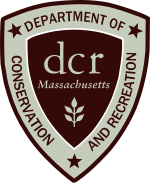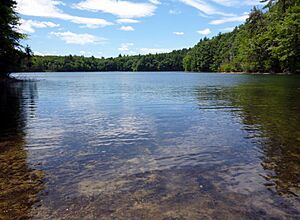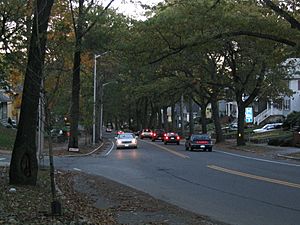Department of Conservation and Recreation facts for kids
The Department of Conservation and Recreation (DCR) is a state agency in Massachusetts. It is part of the Executive Office of Energy and Environmental Affairs. The DCR is famous for its many parks and special roads called parkways.
The main goal of the DCR is "To protect, promote and enhance our common wealth of natural, cultural and recreational resources for the well-being of all." This means they work to keep Massachusetts' natural places, historical sites, and fun outdoor areas safe and enjoyable for everyone. The DCR actually owns more land than any other organization in Massachusetts!
Contents
How the DCR Started
The Department of Conservation and Recreation was created in 2003. This happened when two older agencies, the Metropolitan District Commission (MDC) and the Department of Environmental Management (DEM), joined together.
In 2009, the DCR transferred the ownership and care of many large bridges (not just for walking) to the Massachusetts Department of Transportation.
The current leader of the DCR is Jim Montgomery, who has been the Acting and Interim Commissioner since September 2019.
How the DCR is Organized
The DCR is led by its Commissioner. Several important groups report directly to the Commissioner, including Human Resources, Finance, and External and Legislative Affairs.
The DCR has two main divisions:
- Division of State Parks and Recreation (also known as MassParks)
- Division of Water Supply Protection
It also has several other important groups, like:
- Bureau of Engineering
- Bureau of Planning and Resource Protection
- Bureaus of Forestry and Fire Control
- Bureau of Ranger Services
- Universal Access Program (which helps make parks accessible for everyone)
Division of State Parks: Your Outdoor Fun Guide
The Division of State Parks takes care of over 310,000 acres (1,250 km2) of state-owned forests and parks. These areas are managed in different ways, depending on if they are woodlands, parklands, or reserves.
This division manages many places for outdoor fun. In the greater Boston area, you can find urban wild spaces, historic sites, and beautiful natural spots. The idea for these parks started way back in 1893 with the Metropolitan Park Commission. This was the first regional park system in the United States!
Outside of Boston, the DCR manages:
- About 29 campgrounds where you can stay overnight.
- Over 2,000 miles (3,200 km) of trails for hiking, biking, and exploring.
- 87 beaches for swimming and relaxing.
- 37 swimming, wading, and spray pools.
- 62 playgrounds for kids.
- 55 ballfields for sports.
- 145 miles (233 km) of paved bike and rail trails.
- Even old private homes and estates that are now part of the DCR's Historic Curatorship Program.
Discover Massachusetts State Parks
Division of Water Supply Protection: Keeping Your Water Clean
The Division of Water Supply Protection manages about 150,000 acres (610 km2) of land around water sources. Their main job is to protect the drinking water for about 2.5 million people in Massachusetts, especially in the Greater Boston area. This division checks lakes, ponds, and rainfall across the state to make sure the water stays clean and safe.
Important Water Supply Areas
- Quabbin Reservoir
- Ware River Watershed
- Wachusett Reservoir
- Sudbury Reservoir
Bureau of Engineering: Building and Maintaining Our Parks
The Bureau of Engineering helps design, build, and manage projects for DCR properties. They work on over 450,000 acres (1,800 km2) of parks, forests, watersheds, and beaches. They also manage 340 dams and many recreational facilities.
This Bureau also takes care of over 525 miles of parkways and nearly 300 bridges and tunnels. These are important parts of Massachusetts' transportation system.
The Bureau of Engineering has six main teams:
- Bridge and Parkway Engineering
- Facilities Engineering
- Dams and Waterways Engineering
- Stormwater and Environmental Engineering
- Construction Permitting
- Construction Services
Massachusetts Parkways Managed by DCR
The Bureau of Engineering manages and operates many parkways across Massachusetts, including:
- Alewife Brook Parkway
- Arborway
- Birmingham Parkway
- Blue Hills Parkway
- Blue Hills Reservation Parkways
- Boylston Street (Back Bay sections)
- Breakheart Reservation Parkways
- Cambridge Parkway
- Carey Circle
- Charles River Reservation Parkways
- Charles Street (Charles Circle to Leverett Circle)
- Chestnut Hill Drive
- William J. Day Boulevard
- Fellsway Connector Parkways
- Fellsmere Park Parkways
- Fenway
- Fresh Pond Parkway
- Furnace Brook Parkway
- Hammond Pond Parkway
- Hull Shore Drive
- Jamaicaway
- Land Boulevard
- Lynn Fells Parkway
- Lynnway
- Lynn Shore Drive
- Memorial Drive
- Middlesex Fells Reservation Parkways
- Morrissey Boulevard
- Mount Greylock Summit Road
- Mount Wachusett Summit Road
- Mystic Valley Parkway
- Nahant Beach Boulevard
- Nantasket Avenue
- Neponset Valley Parkway
- North Beacon Street (Brighton & Watertown sections)
- Norumbega Road (Weston)
- Old Harbor Reservation Parkways
- Old Colony Parkway
- Park Drive
- Parkman Drive
- Quincy Shore Drive
- Recreation Road (Weston)
- Revere Beach Boulevard
- Revere Beach Parkway
- Riverway
- Stony Brook Reservation Parkways
- Storrow Drive
- Truman Parkway
- VFW Parkway
- West Roxbury Parkway
- Winthrop Parkway
- Winthrop Shore Drive
Bridges: Connecting Our Communities
Before November 2009, the Bureau of Engineering also managed many bridges across Massachusetts. Most of these bridges, especially those for cars, were transferred to the Massachusetts Department of Transportation. However, the DCR still manages some pedestrian (walking) bridges.
Here is a partial list of notable bridges that were once under the DCR, including pedestrian bridges still managed by the department:
- Alewife Brook Parkway bridge over MBTA
- Anderson Memorial Bridge (aka Larz Anderson Bridge)
- Boston University Bridge
- Beades Bridge
- Bowker Overpass
- Revere Beach Parkway Bridge 23 over B & M, Corporation Way
- Boston University Pedestrian Bridge
- Casassa Overpass
- Casey Overpass
- Charles Circle 57B
- Cradock Bridge
- Craigie Dam Bridge
- Craigie Drawbridge
- Eliot Bridge
- General Edwards Bridge
- General Edwards Electrical Upgrade
- Gilman Street Bridge
- Gilmore Bridge
- Hammond Pond Parkway Bridge/MBTA
- Harvard Bridge
- Lech Walesa Bridge
- Leo Martin Golf Course Pedestrian Bridge
- Leverett Circle Tunnel
- Longfellow Bridge
- McCarthy Overpass
- Mystic Valley Parkway bridge over Alewife Brook
- Neponset River Bridge
- Pleasure Bay Pedestrian Bridges
- Revere Beach Parkway/State Road
- River Street at Mother Brook
- River Street Bridge
- Riverside Park Pedestrian Bridge
- Storrow Drive Tunnel
- Watertown Pedestrian Bridge
- West Roxbury Parkway at Conrail
- Winthrop Avenue Bridge
- Woods Memorial Bridge
Dams: Managing Water Flow
The Bureau of Engineering also owns and manages many dams and flood control facilities across Massachusetts. These help control water levels and prevent flooding. Some examples include:
- Irish Dam (Grafton)
- Moose Hill Reservoir Dam (Spencer)
- Pontoosuc Lake Dam (Pittsfield)
- Unionville Pond Dam (Holden)
- Charles River Dam (Boston)
DCR Services: More Than Just Parks
The DCR is responsible for taking care of its lands. This includes everyday tasks like emptying trash cans, cutting grass, and improving buildings. They also manage the larger landscape of forests and parks.
The DCR helps beyond its own properties too. For example, the Bureau of Forest Fire Control can help local towns during natural disasters or when there's a high risk of forest fires. The Bureau of Forestry also helps manage forests on both state and private lands.
The DCR works with other groups to get things done. Sometimes, the Massachusetts Department of Transportation helps with road repairs at the DCR's request. Police protection in DCR areas is provided by the Massachusetts State Police.
The DCR also partners with local and national volunteer groups. These include the Mystic River Watershed Association, Friends of the Middlesex Fells, and the Appalachian Mountain Club. They also work with student organizations to keep our natural spaces beautiful.





